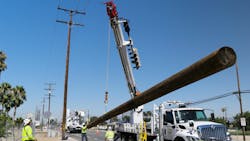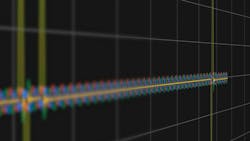SCE Accelerates Fault Detection with the Power of AI
Key Highlights
- AWARE uses waveform signatures to detect and classify early-stage grid faults, enabling proactive intervention.
- The system combines physics-based models with AI/ML to interpret subtle electrical anomalies with high precision.
- By pinpointing fault locations accurately, AWARE reduces restoration times and enhances crew safety and efficiency.
- It operates seamlessly with existing infrastructure, analyzing voltage and current data in real time without requiring new sensors.
- AWARE represents a shift from reactive troubleshooting to predictive maintenance, setting a new standard for utility reliability.
Editor's Note: T&D World, Power Delivery Intelligence Initiative and SCE presented a webinar on this project. To view on-demand, register here.
Imagine having the power to diagnose an illness even before symptoms even appear. While this technology may not yet be widely available with the human body, it is already happening with the electric grid. A new AI tool — the Advanced Waveform Anomaly Recognition (AWARE) system — is capturing the pulse of the grid by installing digital fault recorders (DFRs) at substations to capture distribution voltages and currents.
Two years ago, the Grid Operations team at Southern California Edison (SCE) embarked on the mission to detect grid faults earlier and prevent them from escalating into major outages. By shifting from reactive response to predictive intelligence, the team could catch issues sooner, enable smarter forecasting and reduce restoration times. To accomplish these goals, the AWARE system was born out of necessity.
“We challenged ourselves to move beyond traditional fault-finding techniques and start thinking in patterns,” said Vik Trehan, vice president of Transmission, Substations and Operations at SCE. “Waveforms contain the unique signatures of different failure modes. Learning to interpret those signatures allows us to fundamentally reimagine how we translate raw waveform anomalies into actionable insights.”
SCE was inspired to leverage the sensors already in its system and develop a comprehensive solution combining physics, machine learning and human expertise into a unified, proactive solution.
“The breakthrough was recognizing that waveforms are stories,” Trehan said. “Interpreting those stories allowed us to move beyond reacting to grid issues to anticipating them. AWARE gives us that capability, a step toward an AI-native grid — one that’s smarter, more proactive and ultimately, safer.”
By proactively identifying electric system issues, AWARE is making the grid safer and more reliable for the communities served by SCE, said Pedro J. Pizarro, president and CEO of Edison International, parent company of SCE.
“As homes and businesses increasingly rely on clean energy, using advanced technology can help reduce the number and length of outages and repairs,” Pizzaro said. “When we identify and fix problems faster, customers win with more affordable, available, and reliable electricity.”
Proactively Identifying Grid Issues
The AWARE system can detect early-stage and evolving power system faults long before they become visible through traditional monitoring. It identifies subtle waveform anomalies that correspond to emerging equipment degradation. These faults, left unchecked, can potentially trigger widespread outages or damage infrastructure.
“What sets AWARE apart is its precision: it doesn’t just detect that something is wrong — it identifies what, where and how soon it may fail,” Trehan said. “The system continuously ingests waveform data from existing technologies and applies tailored algorithms to sense meaningful deviation from normal electrical behavior. This enables proactive intervention.”
Instead of waiting for failures to trigger alarms, AWARE reads the warning signs buried in the noise, which makes it possible to isolate risks earlier, prioritize critical assets and guide field response with surgical accuracy. Case in point: in the pilot phase, when smart meter data was captured by AWARE, the locations of issues were accurately identified 80% of the time within the immediate vicinity, sometimes down to a specific piece of equipment.
Diving Into the Technology
At its core, AWARE fuses physics-informed AI/ML with real-time waveform and sensor data to flag early signs of trouble long before traditional alarms go off. It interprets patterns invisible to the human eye and too subtle for conventional monitoring, converting raw waveform “noise” into meaningful fault signatures.
The system continuously processes data, and when something deviates — whether it’s a fractured bushing, a failing capacitor, a loose connector or a potential high-impedance fault —AWARE flags the anomaly, assigns a probable fault type, and correlates it with location and equipment metadata.
But AWARE doesn’t just detect; it classifies. Using signal processing and machine learning layered with physics models, it separates nuisance from necessity, reducing false positives while increasing precision. That means field crews get fewer vague alerts and more actionable ones like the right equipment, right location and right cause.
“The value isn’t just in identifying problems — it’s in shortening the time between insight and response and building trust in an AI system that actually earns its place in operations,” Trehan said.
Throughout the project, Trehan personally oversaw each phase of the implementation, translating high-level strategy into a system capable of operating at the intersection of engineering, AI and real-world operations.
“AWARE was born from a bold vision and a clear mandate: to unify grid technologies and engineering systems, enhance them with AI/ML and shift from reactive outage response to predictive, proactive grid management through disciplined execution,” he said. “The success of this project was driven by the outstanding efforts of the Grid Operations team, whose expertise, innovation and bias for action turned a moonshot concept into a working solution.”
Every phase reflected a culture of ownership and iteration, he said.
“We didn’t just build a tool; we refined a methodology,” he said. “The team pressure tested ideas against real waveform data, worked shoulder-to-shoulder with field resources and architected a scalable platform grounded in physics and practicality,” he said. “The result is an AI-powered anomaly detection system that transforms raw data into foresight and field response into precision action.”
Integrating with Other Applications and Systems
The AWARE system is designed to work alongside other monitoring systems by giving a head start in finding and fixing grid issues and improving reliability for customers. While most existing systems are reactive, AWARE shifts the paradigm.
“AWARE offers a sharper signal-to-noise ratio, earlier detection windows and higher specificity in fault typing,” he said. “It doesn’t flood crews with alerts; it arms them with precision. At its core, AWARE flips the script on outage response. Instead of waiting for something to break, we’re using waveform data to see the break coming.”
SCE has taken measures to proactively mitigate faults before they potentially cascade into outages, often before customers or even crews are aware that anything has gone wrong. This shift from reactive troubleshooting to early-stage detection means fewer surprises, less damage and better outcomes across the board.
“The system estimates fault locations with precision, helping us zero in on high-risk infrastructure quickly and act before failures escalate into safety hazards or customer disruptions,” he said. “Early detection of abnormal conditions enables proactive remediation in high fire-risk areas, an operational advantage that also reduces liability. Fault type identification enhances situational awareness for crews, reducing windshield time and ensuring faster, safer responses.”
Pinpointing anomalies before they escalate shortens restoration time and improves crew efficiency, particularly in difficult settings like underground networks. Ultimately, less downtime and fewer extended outages translate directly into improved customer satisfaction, he said.
“The real power of AWARE isn’t just in finding faults faster — it’s in making them less likely to occur at all,” Trehan said.
Leveraging the Possibilities of AI
The AWARE system can identify unique waveforms for different types of equipment. While most systems search for symptoms, AWARE looks for signatures.
“By analyzing real-time electrical waveforms, AWARE detects subtle anomalies, like equipment wear or abnormal voltage drift, before they evolve into visible failures or outages,” he said. “This ability to recognize early warning signs allows for faster, more precise intervention. It not only boosts grid reliability but reduces customer impact.”
Unlike conventional fault detection tools that treat all disturbances as noise or group them into broad categories, AWARE identifies the unique “fingerprint” of each failure type. For example, the waveform signature of an underground cable fault will look entirely different from an overhead conductor arcing due to wildlife. AWARE’s evolving event catalog makes it possible to match these patterns and triage issues proactively.
“It’s the difference between guessing and knowing, reacting and predicting and a late response and none needed at all,” he said.
While most fault detection systems are narrowly scoped, triggered by known patterns and limited by rigid assumptions, AWARE doesn’t just detect what’s expected, Trehan said. Instead, it learns from the unknown.
AWARE works alongside existing grid technologies, but pushes far beyond them by detecting early, subtle signals of trouble, whether from equipment degradation, wear or emerging anomalies. What sets it apart is not just the data, it’s how SCE uses it.
By leveraging these core capabilities to handle real-world grid data, AWARE sets a new benchmark for applied AI:
- Custom AI/ML design tailored for grid signals. Instead of forcing grid waveform data into off-the-shelf algorithms, AWARE crafts AI/ML features that capture the essence of fault events, unlocking nuanced relationships and surfacing rare failure modes that would otherwise be missed.
- Physics-aware modeling. Because distribution data can be messy, Trehan said, AWARE uses expert-guided physics models to de-noise and contextualize raw signals, increasing confidence and interpretability.
- Low dependence on pre-labeled data. Most machine learning in this space is bottlenecked by signature libraries. AWARE’s architecture minimizes that constraint, making it adaptable across circuits and scalable as new equipment is added.
- Interpretability by design. Because trust matters, AWARE’s outputs are not black boxes. Instead, they’re understandable and traceable, enabling crews to act on them with confidence. In short: AWARE doesn’t just improve fault detection — it rewrites what detection means, he said.
Expediting Restoration Times
Having the ability to pinpoint where failures occur in a service territory through the AWARE system can accelerate restoration times for field crews.
“Knowing exactly where a fault is occurring changes everything,” he said. “Instead of driving miles of line to find the issue, crews can go straight to the source. That means less windshield time, faster repairs and quicker service restoration.”
The new AI tool is not just about speed, but it’s also about precision. AWARE’s pinpointing capability improves safety by giving crews critical situational awareness before they even step out of their truck. In high-risk environments, that knowledge can make all the difference.
“Targeted dispatching also reduces labor strain and restoration costs, turning what used to be a needle-in-a-haystack problem into a direct response mission,” he said.
Unlike other types of technology, AWARE doesn’t require new field sensors. New and added sensors can provide more data and be helpful, but the tool uses SCE’s existing infrastructure to analyze voltage and current patterns in real time. When the system spots a deviation from normal electrical behavior, it flags the anomaly and uses AI to classify it against a growing library of fault signatures. SCE also monitors the system through a dedicated interface and email alerts.
While engineers primarily monitor AWARE, its insights are shared with field crews through dashboards and internal tools. SCE is actively training teams to interpret AWARE data and fold it into daily operations, giving lineworkers better awareness and helping them show up on-site informed and ready to act.
Looking to the Future
In the future, Trehan expects AI and ML to play an increasingly central role in the grid’s future, particularly in predictive maintenance, wildfire mitigation and the integration of distributed energy resources. These tools can help utilities to make faster, smarter and more informed decisions and ultimately, support a more resilient, efficient and sustainable electric grid.
In the meantime, SCE is continuing to build on the success of AWARE by improving how the system predicts and prevents issues.
“It’s already helping us find and resolve problems faster — and we believe other utilities can benefit from this technology, as well,” he said. “AWARE demonstrates how AI and ML can address complex utility challenges while enhancing operational performance.”
Looking ahead, AWARE also lays the groundwork for a future digital twin, an advanced simulation environment that can model grid behavior under extreme weather, load shifts or fault conditions. This capability could allow utilities to test optimization strategies, improve system protection and adapt to evolving grid demands more proactively.
He said AWARE represents more than a system. Instead, it’s a mindset shift that challenges the industry to think differently about fault detection, by moving from reactive triage to anticipatory action.
“What makes this innovation special is that it wasn’t imported from a vendor,” he said. “It was built in-house by people who know the grid and care about its future. That kind of alignment — between technical excellence, field insight and public safety — is rare. We hope AWARE inspires similar efforts across the utility space, where domain-driven innovation can directly protect people, prevent wildfires and reshape how we define reliability.”
AWARE System Earns Electric Power Industry’s Highest Honor: The Edison Award
The Edison Electric Institute (EEI) awarded Edison International and Southern California Edison (SCE) with the 97th Edison Award in June 2025 for the AWARE system. A panel of former electric industry executives selects the recipient annually for this award.
“On behalf of EEI and our member companies, I am proud to congratulate Edison International and Southern California Edison for winning this year’s Edison Award,” said Pat Vincent-Collawn, EEI interim president and CEO. “By developing innovative uses for artificial intelligence to help prevent power outages, Edison International and Southern California Edison are leading by example and showcasing the incredible ingenuity at the heart of our industry’s efforts to enhance the safety, reliability, and resilience of America’s energy grid.”
Trehan said the recognition was deeply humbling and rewarding.
“We’ve created something that can truly make a difference protecting people from getting hurt, preventing outages and reducing the cost of grid maintenance over time,” he said. “Knowing that this innovation came from within our own walls made it even more meaningful. It’s powerful to internalize what this means at the utility level. When you step back and look at our core metrics — customer satisfaction, affordability, reliability and safety — you realize this system touches all of them. There’s something grounding about seeing your own team’s innovation reflected back through outcomes that matter. It’s a reminder that big ideas don’t always come from outside; they can come from the people who know the grid best.”
About the Author
Amy Fischbach
Electric Utilities Operations
Amy Fischbach is the Field Editor for T&D World magazine and manages the Electric Utility Operations section. She is the host of the Line Life Podcast, which celebrates the grit, courage and inspirational teamwork of the line trade. She also works on the annual Lineworker Supplement and the Vegetation Management Supplement as well as the Lineman Life and Lineman's Rodeo News enewsletters. Amy also covers events such as the Trees & Utilities conference and the International Lineman's Rodeo. She is the past president of the ASBPE Educational Foundation and ASBPE and earned her bachelor's and master's degrees in journalism from Kansas State University. She can be reached at [email protected].




